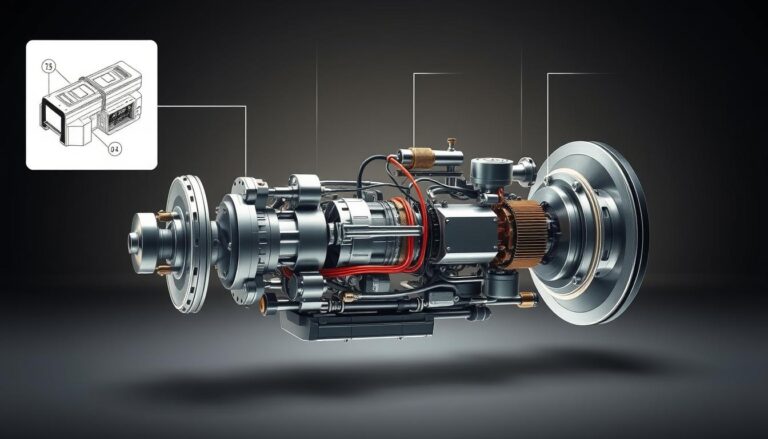Subaru vehicles are celebrated for their safety features, notably the seatbelt alarm, which prompts drivers to fasten their seatbelts. This feature, aimed at fostering safe driving practices, may, for some Subaru owners, become a source of frustration or redundancy in specific contexts.
Disabling the seatbelt chime presents a practical solution for those who are cognizant of the hazards and seek to reduce distractions during the drive. It is crucial to acknowledge that safety must remain paramount, and drivers should be mindful of the potential repercussions of deactivating this feature.
Key Takeaways
- Understand the importance of Subaru’s safety features
- Learn how to disable the seatbelt alarm
- Be aware of the potential risks and consequences
- Follow easy steps to disable the seatbelt chime
- Prioritize safe driving habits
Understanding Seatbelt Alarms in Subaru Vehicles
The intricacies of the seatbelt reminder system within Subaru models underscore the brand’s commitment to vehicular safety. This system is pivotal, ensuring that all occupants are securely fastened, thus mitigating the risk of injury during vehicular accidents.
How the Seatbelt Reminder System Functions
The Subaru seatbelt reminder system integrates sensors and alarms to prompt drivers and passengers to secure their seatbelts. Upon ignition, the system verifies the status of seatbelt fastening. In the event of non-compliance, it activates an audible alert and displays a dashboard warning light.
Differences Between Older and Newer Subaru Models
Comparatively, older Subaru models feature a less complex seatbelt reminder system. In contrast, newer models boast enhanced safety features, including adaptive cruise control and lane departure warning systems, reflecting a significant leap in vehicular technology.
Why These Safety Features Exist
The primary purpose of these safety features is to diminish the incidence of road-related injuries and fatalities. Subaru owners, by grasping the functionality of these systems, can enhance their appreciation for the vehicle’s design and operational capabilities.

Safety Considerations and Legal Implications
The decision to disable the seatbelt alarm in a Subaru necessitates a comprehensive understanding of the attendant risks and legal consequences. The intention behind such an action, aimed at circumventing the annoyance of alarms, must be weighed against the overarching safety and legal considerations.
The Importance of Wearing Seatbelts
Seatbelt utilization is a cornerstone of vehicular safety. It substantially diminishes the risk of fatal injury during accidents. The National Highway Traffic Safety Administration (NHTSA) has documented that the use of a seatbelt can reduce the risk of death by up to 45%.
Legal Requirements for Seatbelt Use in the US
In the United States, the legal mandates for seatbelt utilization differ by state, yet all states enforce such laws. For example, New Hampshire stands as the sole state without a primary enforcement seatbelt law for adults. Despite this, drivers and passengers under specific age thresholds are mandated to wear seatbelts.

Potential Insurance Implications
The act of disabling the seatbelt alarm may have repercussions on insurance claims. In the event of an accident, if it is ascertained that not wearing a seatbelt contributed to injuries, the insurance claim could be impacted.
Risks of Disabling Safety Features
Disabling safety features, such as the seatbelt alarm, elevates the risk of involvement in accidents without the protective advantages of a seatbelt. It is imperative to meticulously consider these risks.
| State | Primary Enforcement Law | Secondary Enforcement Law |
|---|---|---|
| California | Yes | No |
| New York | Yes | No |
| New Hampshire | No | Yes (for under 18) |
Grasping these elements is critical before making any decisions regarding your vehicle’s safety features.
Disable Seatbelt Alarm in Subaru: How To Do This Safely?
To disable the seatbelt alarm in your Subaru, it is imperative to grasp the available methodologies. The act of disabling the seatbelt alarm, while potentially beneficial for certain Subaru proprietors, necessitates a cautious approach.
Temporary vs. Permanent Disabling Methods
The primary methodologies for disabling the seatbelt alarm are temporary and permanent. Temporary methods might entail the utilization of specific techniques or tools to mute the alarm for a specific duration. In contrast, permanent disabling necessitates more profound alterations to the vehicle’s system.
It is paramount to evaluate the advantages and disadvantages of each approach. Temporary solutions might be more appropriate for individuals who prefer not to alter their vehicle’s configurations permanently.
Tools and Materials You’ll Need
The tools or materials required will depend on the chosen methodology. For certain Subaru models, a diagnostic tool may be essential to access and modify the vehicle’s settings. It is imperative to verify that any tools or materials employed are compatible with your Subaru model.
Precautions Before Starting Any Modification
Before embarking on any modifications, it is crucial to consider the safety implications. Disabling the seatbelt alarm should not undermine the safety features of your Subaru. Always consult your vehicle’s manual and consider seeking professional advice if in doubt.
Warranty Considerations
Modifying your Subaru’s settings, including disabling the seatbelt alarm, may have implications for your vehicle’s warranty. It is essential to review your warranty terms before proceeding with any modifications to avoid potential complications.
By comprehending the available methodologies and adhering to necessary precautions, you can safely disable the seatbelt alarm in your Subaru. Prioritize safety and consider the potential repercussions on your vehicle’s warranty.
Method1: Using the Buckle Technique for Older Subaru Models
The buckle technique presents a direct approach to disable the seatbelt alarm in older Subaru models, proving invaluable for those where the alarm becomes a hindrance. By mastering this technique, Subaru owners can significantly enhance their driving experience, eliminating the annoyance of the alarm.
Compatible Models
Subaru models such as the Forester, Outback, and Legacy, produced prior to 2015, are amenable to the buckle technique. These vehicles often feature a rudimentary seatbelt alarm system, making it easier to manipulate using this method.
Step-by-Step Instructions with Timing
To disable the seatbelt alarm, adhere to the following protocol:
- Insert the buckle into the latch, ensuring it clicks into place.
- Wait for 30 seconds to allow the system to recognize the buckle.
- Remove the buckle and repeat the process a few times.
This procedure generally requires approximately 2 minutes to execute.
Verifying the Alarm is Disabled
Post-completion of the buckle technique, initiate the vehicle and verify if the seatbelt alarm is muted. If the alarm persists, reinitiate the process to confirm its deactivation.
Reversing the Process if Needed
To reactivate the seatbelt alarm, merely repeat the buckle technique several times. The system should return to its default state, ensuring the alarm operates as designed.
It is imperative to acknowledge that while disabling the seatbelt alarm may offer convenience, safety must remain paramount. As a Subaru aficionado aptly remarks, “Safety features are in place for a reason; utilize them judiciously.” Always weigh the consequences of altering your vehicle’s safety configurations.
Method2: Using the Diagnostic Port for Newer Subaru Models
For owners of newer Subaru models, the diagnostic port offers a pathway to disable the seatbelt alarm system. This approach is notably beneficial for vehicles such as the Impreza, Crosstrek, and Ascent, produced from 2015 onwards.
Compatible Models
Subaru models from 2015, including the Impreza, Crosstrek, and Ascent, are equipped with advanced diagnostic ports. These ports enable owners to access and modify various settings, including the seatbelt alarm system.
Required Diagnostic Tools
To disable the seatbelt alarm via the diagnostic port, a compatible diagnostic tool is essential. Several options are available:
- Subaru Select Monitor (SSM)
- ROM ID device
- Third-party diagnostic tools compatible with Subaru vehicles
Accessing and Modifying Vehicle Settings
To access the vehicle settings, follow these steps:
- Locate the diagnostic port in your Subaru vehicle, typically found under the steering column.
- Connect the diagnostic tool to the port.
- Follow the tool’s instructions to access the vehicle’s settings menu.
- Navigate to the “Seatbelt Alarm” or “Safety Features” section.
- Select the option to disable the seatbelt alarm.
Confirming Successful Deactivation
Verify the seatbelt alarm’s deactivation by checking the dashboard for alert messages or by testing the seatbelt system.
| Model | Year | Diagnostic Tool Required |
|---|---|---|
| Impreza | 2015+ | SSM or ROM ID |
| Crosstrek | 2015+ | SSM or ROM ID |
| Ascent | 2019+ | SSM or Third-party tools |
Alternative Solutions to Complete Disabling
For Subaru proprietors desiring to circumvent the total disablement of the seatbelt alarm, several alternatives present themselves. These options aim to mitigate the alarm’s drawbacks without undermining the vehicle’s safety apparatus.
Seatbelt Extenders and Adapters
Seatbelt extenders or adapters emerge as a viable solution. These tools facilitate a more comfortable seating arrangement, potentially obviating the necessity for alarm disablement. Seatbelt extenders are notably beneficial for those encountering the standard seatbelt as too restrictive or uncomfortable.
Adjusting Alarm Volume Settings
Subaru models permitting volume adjustments of the seatbelt alarm offer a middle ground. By attenuating the alarm’s volume, its intrusiveness diminishes, presenting a practical alternative to complete disablement.
Third-Party Devices and Their Effectiveness
Third-party solutions purport to rectify seatbelt alarm malfunctions without compromising safety. These products, while potentially efficacious, necessitate meticulous selection to ensure congruence and dependability.
Pros and Cons of Each Alternative
Each alternative harbors its own set of advantages and disadvantages. Seatbelt extenders, for example, can elevate comfort but may encounter compatibility hurdles with certain Subaru variants. Adjusting the alarm volume serves as a temporary palliative but fails to address the underlying issue. Third-party devices, while potentially effective, introduce additional financial burdens.
| Alternative Solution | Pros | Cons |
|---|---|---|
| Seatbelt Extenders/Adapters | Enhances comfort, potentially reduces need to disable alarm | Compatibility issues, additional cost |
| Adjusting Alarm Volume | Reduces intrusiveness of the alarm | May not be available in all models, doesn’t address root cause |
| Third-Party Devices | Can be effective, various options available | Compatibility issues, additional cost, reliability concerns |
Troubleshooting Common Issues
In the endeavor to disable the seatbelt alarm within your Subaru, several prevalent issues may arise, necessitating specific troubleshooting methodologies.
Alarm Continues Despite Attempted Disabling
Should the seatbelt alarm persist in its auditory assault post-attempt at deactivation, several potential culprits warrant investigation. Initially, verify the seatbelt buckle’s engagement status and scrutinize for any obstructions or debris impeding its functionality.
- Ensure the seatbelt is not entangled or snagged on any object.
- Inspect for any software enhancements for your Subaru’s infotainment system, as such updates might rectify the problem.
Check Engine Light or Error Codes
Should the check engine light illuminate or an error code manifest subsequent to seatbelt alarm deactivation attempts, it is imperative to diagnose the issue with a compatible scan tool. This diagnostic process is crucial for uncovering any underlying malfunctions requiring attention.
Resetting the System After Failed Attempts
In the event of unsuccessful attempts to disable the seatbelt alarm, a system reset may be required. This procedure generally involves disconnecting the vehicle’s battery for a brief interval and then reconnecting it.
- Confirm the vehicle is in an off state and in park position.
- Remove the negative battery cable.
- Allow a 5-10 minute interval before reconnecting the cable.
When to Seek Professional Assistance
Should personal troubleshooting efforts prove ineffective, it is advisable to seek professional assistance. A certified Subaru technician or a seasoned auto electrician can offer the requisite expertise to diagnose and rectify the issue.
Conclusion
The process of disabling the seatbelt alarm in Subaru vehicles varies significantly across different models and years. For instance, models such as the Forester, Outback, and Legacy prior to 2015 can be managed through the buckle technique. In contrast, newer models, including the Impreza, Crosstrek, and Ascent from 2015 onwards, necessitate the use of diagnostic tools to modify vehicle settings.
It is imperative to consider the implications of disabling the seatbelt alarm in light of Subaru’s safety features. The methods discussed offer a solution for those who must disable the alarm. Yet, it is crucial to evaluate the potential risks and legal ramifications. Subaru’s safety features are integral to road safety, emphasizing the importance of wearing seatbelts.
In summary, when contemplating the disablement of the seatbelt alarm in your Subaru, it is essential to comprehend the potential consequences. Exploring alternative solutions, such as seatbelt extenders or adjusting alarm volume settings, is advisable. This approach ensures a safe and compliant driving experience.
FAQ
How do I disable the seatbelt alarm in my Subaru?
The procedure to disable the seatbelt alarm in a Subaru is contingent upon the model’s generation. For models predating the current era, the buckle technique serves as a viable solution. In contrast, newer iterations necessitate the utilization of the diagnostic port for modification.
Is it safe to disable the seatbelt alarm in my Subaru?
Disabling the seatbelt alarm may compromise the vehicle’s safety integrity. It is imperative to consider the potential risks and explore alternative solutions. Options include adjusting the alarm’s volume or employing seatbelt extenders, which may mitigate the need for alarm system modification.
What are the legal implications of disabling the seatbelt alarm?
Disabling the seatbelt alarm may have significant insurance implications and could be subject to local laws and regulations. It is crucial to verify the legal requirements for seatbelt use within your jurisdiction.
Can I disable the seatbelt alarm temporarily?
Yes, certain methods facilitate the temporary disabling of the seatbelt alarm. It is,etheless, essential to adhere to the correct procedure to avoid potential risks or complications.
Will disabling the seatbelt alarm void my Subaru’s warranty?
Modifying your Subaru’s safety features, including the disabling of the seatbelt alarm, may impact your vehicle’s warranty. It is advisable to consult with a Subaru dealership or an authorized service center prior to any modifications.
What are the compatible Subaru models for the buckle technique?
The buckle technique is compatible with older Subaru models, including the Forester, Outback, and Legacy pre-2015.
What diagnostic tools are required to disable the seatbelt alarm in newer Subaru models?
Newer Subaru models, such as the Impreza, Crosstrek, and Ascent 2015+, necessitate specific diagnostic tools to access and modify vehicle settings.
Can I reset the seatbelt alarm system after attempting to disable it?
Yes, resetting the seatbelt alarm system is feasible. The process, though, may vary based on the method employed to disable the alarm and the Subaru model in question.
When should I seek professional assistance for disabling the seatbelt alarm?
If you are uncertain about the process or encounter any issues while attempting to disable the seatbelt alarm, seeking professional assistance from a Subaru dealership or an authorized service center is advisable.


